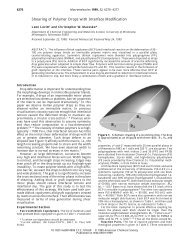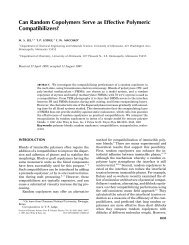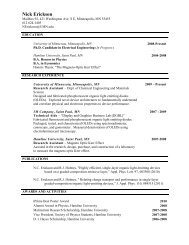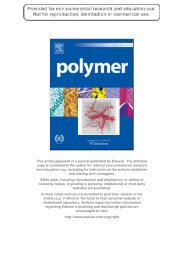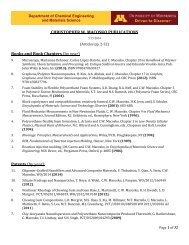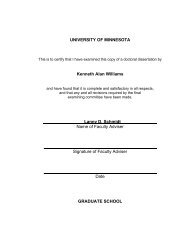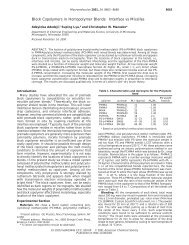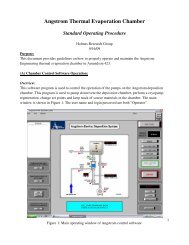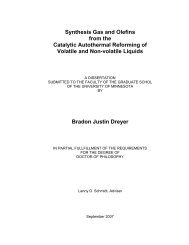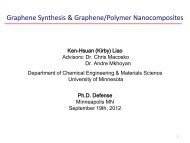Linear low density polyethylene (LLDPE) - University of Minnesota
Linear low density polyethylene (LLDPE) - University of Minnesota
Linear low density polyethylene (LLDPE) - University of Minnesota
Create successful ePaper yourself
Turn your PDF publications into a flip-book with our unique Google optimized e-Paper software.
A. Durmus et al. / Polymer 48 (2007) 4492e45024493groups, called as compatibilizers or interfacial agents, must beintroduced in the nanocomposite formulations to increase theinterfacial interactions between the clay layers and the polyolefinmatrix [1]. The most widely used compatibilizer is maleicanhydride grafted polyolefins. Nanocomposite formationis a very complex phenomenon for the polyolefins even witha compatibilizer. Graft ratio and molecular weight <strong>of</strong> the compatibilizer,miscibility with the base polyolefin, compatibilizer/nano-filler weight ratio (a) and processing conditions are importantparameters for the final structure and physical properties<strong>of</strong> the nanocomposite. It has been reported that highermaleic anhydride graft ratio onto the compatibilizer or usinga high amount <strong>of</strong> compatibilizer in nanocomposite compositionscould cause miscibility problems between the compatibilizerand main polymer phases. Optimum compatibilizer/filler weight ratio (a) has been proposed as 3 in order to achievea good clay dispersion and physical enhancement for the polyolefinnanocomposites [6,7].Many studies have been reported on the polypropylenenanocomposites prepared by melt blending using maleic anhydridegrafted polypropylenes (PP-g-MA) used as compatibilizer[8e13]. Polyethylene-based nanocomposites are muchless studied. Although some attempts were reported to createnanocomposites with various grades <strong>of</strong> <strong>polyethylene</strong>s and claysboth <strong>of</strong> which were commercially available, only few successfulresults were obtained due to the chemical structure <strong>of</strong> thePE [14e16]. Most studies in the field <strong>of</strong> polyolefin/org-claynanocomposites were focused on the effects <strong>of</strong> clay and compatibilizeramount, intercalant structure between the claylayers and processing conditions on nanocomposite propertiesrather than the structural features <strong>of</strong> polymeric compatibilizers.In a few studies, some authors <strong>of</strong>fered that <strong>low</strong> molecular weightreactive compounds can be used successfully as compatibilizerfor the polyolefin nanocomposites [17,18]. They proposedthat these functional oligomeric compounds can easily diffusethrough the clay galleries and cause an extra delamination becausethey have much higher mobility than the high molecularweight equivalents during the nanocomposite processing.In this study, we have focused on preparing linear <strong>low</strong> <strong>density</strong><strong>polyethylene</strong> (<strong>LLDPE</strong>)/org-clay nanocomposites with improvedphysical properties for barrier film applications. Wehave also attempted to use a <strong>low</strong> molecular weight oxidized<strong>polyethylene</strong> (OxPE) as compatibilizer. Oxidized <strong>polyethylene</strong>is a modified, <strong>low</strong> molecular weight <strong>polyethylene</strong> that containsvarious functionalities such as mainly carboxylic acids, estersand ketones. It has been used as processing aid in some polymerand coating formulations. Krupa et al. used a <strong>low</strong> molecularweight oxidized FischereTrops wax (M w ¼ 785 g mol1 )in polyolefin blends and reported the effects <strong>of</strong> the oxidizedwax on the polarity <strong>of</strong> the system and corresponding thermaland mechanical properties <strong>of</strong> the oxidized wax/polyolefinblends [19,20]. They found that the 10% weight concentration<strong>of</strong> the oxidized wax increased the blend polarity 10 times incase <strong>of</strong> LDPE and 4.5 times for the HDPE, based on the surfacefree energy measurements [21]. Oxidized polypropylene(OxPP) was also used to enhance compatibility <strong>of</strong> polypropylene(PP)/nylon6 blends [22].In this study, org-clay dispersion in <strong>LLDPE</strong> phase wasquantified by the melt state rheological behavior <strong>of</strong> the samplesand also investigated by XRD and TEM studies dependingon the compatibilizer structure. Thermal, mechanical andgas permeability properties <strong>of</strong> these samples will be reportedin second part <strong>of</strong> the study.2. Experimental2.1. MaterialsPolymers used in this study are listed in Table 1. <strong>Linear</strong> <strong>low</strong><strong>density</strong> <strong>polyethylene</strong> (<strong>LLDPE</strong>) supplied by ExxonMobil(LL3003 Ò ) was used as polymer matrix having a number molecularweight (M n ) <strong>of</strong> 50 kg mol1 . Two commercial compatibilizers,a maleic anhydride grafted <strong>polyethylene</strong> donated byCrompton (Polybond Ò 3029) and a <strong>low</strong> molecular weight oxidizedPE donated by Honeywell (AC Ò 330) were used ascompatibilizers. Melt f<strong>low</strong> index (MFI) values <strong>of</strong> the <strong>LLDPE</strong>and PE-g-MA are 3.2 g 10 min 1 and 4 g 10 min 1 , respectively(ASTM D1238, 190 C, 2.16 kg). Melt viscosity <strong>of</strong>the AC Ò 330 was reported as 3600 cps at 150 C. Hereafterthe compatibilizers are denoted as PE-g-MA for the PolybondÒ 3029 and OxPE for the AC Ò 330. The clay used inthis study was a commercial organo-clay supplied from SouthernClay (Cloisite Ò 20A). Cloisite Ò 20A is dimethyl dihydrogenatedtal<strong>low</strong> quaternary ammonium (2Me2HT) salt modifiedmontmorillonite (org-clay). The organic content <strong>of</strong> Cloisite Ò20A was reported as 38% by the manufacturer [23].2.2. Melt processingSamples were prepared by melt blending in a DACA MiniCompounder, a vertical co-rotating twin screw extruder, witha re-circulation channel. Polymers and org-clay, dried in anair circulating oven at 80 C overnight, were mixed manuallyand loaded into the compounder. All batches, weighing 4 geach, were processed at 180 C with a screw speed <strong>of</strong> 100 rpmfor 15 min under nitrogen. The maximum shear rate for thisinstrument was estimated to be 60 s 1 at 100 rpm. Then thesamples were extruded for about 3 min and cooled down toroom temperature. Sample compositions varying with thecompatibilizer type and org-clay content from 1 phr (part perhundred <strong>of</strong> the polymer matrix) to 10 phr are listed in Table 2.Different compositions were designated as MA-x and OxPExwhere x represents the clay amount as phr and MA andOxPE represent the compatibilizers, maleic anhydride graftedTable 1Some properties <strong>of</strong> the polymers usedPolymer M n PDI d (g/cm 3 ) Functional group characteristics<strong>LLDPE</strong> 50,000 5.5 0.9175 ePE-g-MA e e 0.9600 MAH ¼ 1.6AN ¼ 18.3OxPE 2950 3.2 0.9900 AN ¼ 30MAH: maleic anhydride graft ratio (wt%), AN: acid number (mg KOH/g).
4494 A. Durmus et al. / Polymer 48 (2007) 4492e4502Table 2Sample compositionsSample Polymer Compatibilizers Org-clay<strong>LLDPE</strong> PE-g-MA OxPE Cloisite 20A (phr)<strong>LLDPE</strong> 100 eC5 95 5MA-1 97 3 1MA-2 94 6 2MA-3 91 9 3MA-5 85 15 5MA-8 74 24 8MA-10 70 30 10OxPE-1 97 3 1OxPE-2 94 6 2OxPE-3 91 9 3OxPE-5 85 15 5OxPE-8 74 24 8OxPE-10 70 30 10C5: control sample.<strong>polyethylene</strong> and oxidized <strong>polyethylene</strong>, respectively. Compatibilizer/org-clayweight ratio (a) was taken constant as 3 ineach composition to provide a constant dispersion state forthe org-clay. Mixing torque (Nm) and load (N) values wererecorded during the melt processing.A control sample (hereafter named as C5) having 5 (wt%)org-clay (95 <strong>LLDPE</strong>/5 Cloisite Ò 20A) without compatibilizerwas also prepared at the same processing conditions.2.3. Sample characterization2.3.1. Rheological measurementsViscoelastic behavior <strong>of</strong> the nanocomposites were analyzedby a dynamic oscillatory rheometer in the melt state. Acontrolled strain rheometer (ARES, Advanced RheometricExpansion System, Rheometric Scientific) equipped with25 mm diameter parallel plate geometry was employed forthe rheological tests. Samples were directly loaded andmolded between the plates and rheological tests were carriedout at 160 C with a gap distance <strong>of</strong> 0.9e1 mm under nitrogenatmosphere. First, strain sweep test was performed fromthe initial strain value <strong>of</strong> 0.1 to a final strain value <strong>of</strong> 100 inpercent, with the frequency <strong>of</strong> 1 rad/s to determine the linearviscolelastic region <strong>of</strong> the samples. Storage modulus (G 0 )and loss modulus (G 00 ) were recorded as a function <strong>of</strong> shearstrain (g%).In frequency sweep test, a small amplitude oscillatory shear,g ¼ g 0 sinðutÞ, was applied to the samples. Resulting shearstress was recorded as:2.3.2. Wide angle X-ray diffraction (WAXD)WAXD method was used to characterize org-clay dispersionin <strong>LLDPE</strong>. Extruded samples were analyzed by a Bruker-AXSRapid XRD Microdiffractometer in the 2q range from 1 to12 with the steps <strong>of</strong> 0.02 , at room temperature to obtainmicrostructural information <strong>of</strong> the nanocomposites as well asthe extent <strong>of</strong> clay dispersion.2.3.3. Transmission electron microscopy (TEM)Clay dispersion in nanocomposite samples was also observedby the transmission electron microscopy (TEM),(JEOL 1210 with an acceleration voltage <strong>of</strong> 120 kV). Extrudedsamples were microtomed in the form <strong>of</strong> very thin slices(
A. Durmus et al. / Polymer 48 (2007) 4492e45024495<strong>of</strong> the org-clay layers. Increase in mixing torque could reflecton the fracturing <strong>of</strong> the clay particles into smaller aggregatesand undergoing delamination. But in this case, we have mainlydeduced that delamination rate can be compared by consideringthe mixing torque behavior <strong>of</strong> the nanocomposites preparedwith different types <strong>of</strong> compatibilizers. It is known thatinteractions between the clay layers and polymer chains andshear forces created in melt blending are major factors in thedispersion <strong>of</strong> clay in polymer/clay nanocomposites. PE-g-MAcompatibilizer created a relatively high mixing torque values.On the other hand, compatibilizereclay affinity should behigher in nanocomposite series prepared with the OxPE thanthose in the MA series as its eCOOH functionality (indicatedby the acid number, mg KOH/g) is higher than that <strong>of</strong> PE-g-MA. However, mixing torque <strong>of</strong> the OxPE-5 sample is much<strong>low</strong>er than that <strong>of</strong> MA-5. It can be expected that diffusion <strong>of</strong>the OxPE chains through the clay galleries is relatively fastdue to higher mobility <strong>of</strong> OxPE chains and relatively high affinityand interactions between eOH groups on the clay surfacesand functional groups <strong>of</strong> the OxPE. Similar explanationwas proposed by Kawasumi et al. for the dispersion mechanism<strong>of</strong> clay layers in polypropylene (PP) using <strong>low</strong> molecularweight (M w ¼ 30,000 g mol1 and 40,000 g mol1 ) oligomericmaleic anhydride grafted polypropylenes (PP-g-MA) as compatibilizer[8]. On the other hand, in case <strong>of</strong> OxPE, it wasclearly seen that <strong>low</strong> M w compatibilizer (OxPE) cannot yielda high shear value that is required for an effective dispersion<strong>of</strong> the clay layers into polymer phase. It has been reportedthat <strong>low</strong> torque in processing leads to poor clay dispersionin polymer nanocomposites [7,25].Increase in mixing torque for the nanocomposites seriesprepared with the OxPE could be explained by the fact thatclay layers were gradually delaminated and delamination rateis probably much s<strong>low</strong>er than in the case <strong>of</strong> relatively higherM w compatibilizer (PE-g-MA). For longer mixing time, mixingtorque may reach a plateau as seen in physical gelation.Consequently, although functionality (acid number) <strong>of</strong> OxPEis higher than that <strong>of</strong> PE-g-MA, it may be expected that theOxPE could yield poor clay dispersion because effective shearforces could not be created during the melt processing.3.2. Rheological behaviors3.2.1. Strain dependence <strong>of</strong> viscoelastic behaviorRheological behavior <strong>of</strong> polymer composites in melt stateis very critical to understand processability and structureeproperty relationships for these materials. On the other hand,melt rheology measurements can probe behavior <strong>of</strong> the relativelylarge material that is crucial from the macroscopic point<strong>of</strong> view. In rheological tests, first dynamic strain sweep testwas applied to nanocomposite samples in order to characterizestrain dependence <strong>of</strong> the viscoelastic properties <strong>of</strong> the samplesand determine linear viscoelastic (LVE) region. Since the storagemodulus (G 0 ) is a more sensitive rheological function thanthe loss modulus (G 00 ) to the structural changes <strong>of</strong> the nanocomposites,only the storage modulus curves are presentedin this study. Dependence <strong>of</strong> storage modulus (G 0 ) on the strain(a)G' [Pa](b)G' [Pa]10 410 32x10 310 3MA-10MA-8MA-50.1 1 10 100γ (%)MA-3MA-2MA-1<strong>LLDPE</strong>OxPE-10OxPE-8OxPE-5OxPE-3<strong>LLDPE</strong>OxPE-1OxPE-2Fig. 2. Storage modulus (G 0 ) vs. strain (g%) curves <strong>of</strong> the nanocompositesprepared with (a) PE-g-MA and (b) OxPE as compatibilizers.(g%) for the sample series prepared with the PE-g-MA andOxPE is given in Fig. 2. Storage modulus (G 0 ) <strong>of</strong> all the samplesexhibits a linear region (Newtonian plateau) at <strong>low</strong> strainsand non-linear region at high strain amplitudes. It was observedthat the plateau modulus readily increases with theclay amount for the MA series. But plateau modulus (G 0 p)values are <strong>low</strong>er than modulus <strong>of</strong> <strong>LLDPE</strong> for the <strong>low</strong> clayloaded OxPE-x samples. It could be attributed to effects <strong>of</strong><strong>low</strong> molecular weight and <strong>low</strong> melt viscosity <strong>of</strong> OxPE attest temperature. Such effect is more pronounced be<strong>low</strong> theorg-clay amount <strong>of</strong> 3 phr which might correspond to networkformation (percolation).Strain dependence <strong>of</strong> normalized storage modulus(G 0 r ¼ G 0 /G 0 p) <strong>of</strong> <strong>LLDPE</strong>, C5 and the nanocomposite samples,MA-5 and OxPE-5 are shown in Fig. 3. It was observed fromthe strain sweep test results that deviation from the linear viscoelasticbehavior for the nanocomposites starts at <strong>low</strong>erstrains than both <strong>LLDPE</strong> and C5 samples. Transition pointwhich appeared at the deviation region from the linear tonon-linear viscoelastic behavior is defined as critical strain(g c ). Critical strain value (g c ) varies with the clay contentand dispersion quality depending on the nanocomposite composition.g c was generally taken as the strain value at the storagemodulus equal to 90% <strong>of</strong> the plateau modulus (0.9 G 0 ).
4496 A. Durmus et al. / Polymer 48 (2007) 4492e4502G ' r10.90.80.7<strong>LLDPE</strong>C5MA-5OxPE-50.1 1 10 100γ (%)Fig. 3. Normalized storage modulus (G r 0 ) vs. strain (g%) curves <strong>of</strong> the <strong>LLDPE</strong>(,), control sample (C), MA-5 (6) and OxPE-5 (;) samples.Plots <strong>of</strong> the critical strain values against the clay volume fraction(f) are given in Fig. 4 for the samples series. It indicatesthat the strain limits <strong>of</strong> linear viscoelastic region <strong>of</strong> <strong>LLDPE</strong>/org-clay nanocomposites is very sensitive to clay amount. g cvalues decrease to a strain level <strong>of</strong> 10% for the high org-clayloaded nanocomposites, however, it is about 80e90% for the<strong>LLDPE</strong>, C5 and <strong>low</strong> amount <strong>of</strong> org-clay loaded samples.OxPE series exhibit higher g c values than the PE-g-MA seriesat a given clay amount. These results indicate the microstructuraldifferences in samples and also the effects <strong>of</strong> compatibilizertype on the the clay dispersion and resulting rheologicalbehavior <strong>of</strong> the nanocomposites. Moreover, it is observedthat the critical strain values display a power law dependencyon the volume fraction <strong>of</strong> clay (g c f f n ). Power law slopes ona logelog scale were found as 1.1 for the MA series and0.85 for the OxPE series. Some authors have suggestedthat strain dependence <strong>of</strong> clay amount in nanocompositescan be explained by the network formation and by the effects100<strong>of</strong> alignment <strong>of</strong> the anisotropic clay layers to the strain directionand rupture <strong>of</strong> some particleeparticle interactions <strong>of</strong> thephysical network [26,27].3.2.2. Frequency dependence <strong>of</strong> viscoelastic behaviorDynamic frequency sweep tests were conducted in linearviscoelastic region (g ¼ 0.02) to further study on network formationand microstructural changes <strong>of</strong> the nanocomposites indetail. First, we compared the rheological behavior <strong>of</strong> the<strong>LLDPE</strong>, C5, MA-5 and OxPE-5 samples to understand the effects<strong>of</strong> the compatibilizer type on the interfacial interactionsbetween the clay layers and polymer chains. Fig. 5 shows thefrequency dependence <strong>of</strong> storage modulus (G 0 ) and dynamicviscosity (h*) <strong>of</strong> the <strong>LLDPE</strong>, C5, MA-5 and OxPE-5 samplesobtained from the frequency sweep test. It is seen that G 0 <strong>of</strong>the MA-5 is the highest in entire range <strong>of</strong> frequency studied.Especially at <strong>low</strong> frequency region, it was observed that G 0for the MA-5 and OxPE-5 becomes frequency independentwhich is the characteristic behavior <strong>of</strong> solid-like materials.Low frequency improvement in G 0 indicates strong interactionsbetween the clay layers and polymer matrix. This behaviorand magnitude <strong>of</strong> the G 0 enhancement at <strong>low</strong> frequencyregion will be discussed in the fol<strong>low</strong>ing for quantifying clay(a)G' [Pa](b)10 510 410 310 210 110 0<strong>LLDPE</strong>C5MA-5OxPE-5<strong>LLDPE</strong>C5MA-5OxPE-5γ c (%)10* [Pa.s]10 5 ω (rad/s)10 410 310.01 0.1Fig. 4. The dependence <strong>of</strong> critical strain (g c ) on the clay volume fraction (f)for the sample series prepared with the PE-g-MA (,) and OxPE (C).0.01 0.1 1 10 100Fig. 5. Comparison <strong>of</strong> the rheological behavior <strong>of</strong> the <strong>LLDPE</strong>, control sample(C5) having 5 phr org-MMT without compatibilizers, MA-5 and OxPE-5. (a)dependence <strong>of</strong> storage modulus (G 0 ) on frequency, (b) dependence <strong>of</strong> dynamicviscosity (h*) on frequency.
A. Durmus et al. / Polymer 48 (2007) 4492e45024497dispersion. G 0 values at u ¼ 0.01 rad/s are 1.5, 2.8, 2230 and107 Pa for <strong>LLDPE</strong>, C5, MA-5 and OxPE-5, respectively.These results imply that there is no interaction between theorg-clay layers and <strong>LLDPE</strong> chains, and 5% (wt) <strong>of</strong> the orgclaycannot show a significant filler effect without a compatibilizer.Thus, C5 sample could be defined as a ‘‘macro-composite’’.On the other hand, considering the G 0 enhancement at terminalregion, it is clearly shown that the OxPE creates a significantinteraction at the interface between the polymer and claylayers but this enhancement is <strong>low</strong>er than the samples preparedwith the PE-g-MA at a particular org-clay amount. It may beexpected that clay layers show better dispersion in MA seriesthan the OxPE series for a given sample composition.<strong>LLDPE</strong> and C5 showed a Newtonian plateau in h*eucurve (Fig. 5b) at <strong>low</strong> frequency region which implies that5 phr <strong>of</strong> org-clay does not affect the dynamic viscosity <strong>of</strong>the polymer phase without a compatibilizer. Zero shear rateviscosity (h 0 *) values, obtained experimentally at the frequency<strong>of</strong> u ¼ 0.01 rad s 1 are 5231 and 5845 Pa s for theC5 and <strong>LLDPE</strong>, respectively. But it was observed that the dynamicviscosity <strong>of</strong> nanocomposite samples including 5 phr <strong>of</strong>org-clay increased dramatically at <strong>low</strong> frequencies. Increase inviscosity at <strong>low</strong> frequency region also shows effects <strong>of</strong> compatibilizeron the interfacial interactions and clay dispersion inpolymer phase. Moreover, viscosity curves at <strong>low</strong> frequencyregion could be fitted by the power law model. Several authorshave used h*eu curves to determine power law parametersand explain shear thinning behavior <strong>of</strong> the polymer nanocompositesat <strong>low</strong> frequency region [28,29]. For the frequencysweep data, power law expression is written ash ¼ ku nwhere h* is a dynamic viscosity, k is a sample specific preexponentialfactor, u is the oscillation frequency in the frequencysweep test and n is the shear thinning exponent. kand n can be directly determined from the logarithmic plot<strong>of</strong> viscosity (h*) vs. frequency (u) aslogðh Þ¼log k þ nlogðuÞShear thinning exponent, n, is the slope <strong>of</strong> straight line obtainedby plotting log(h*) vs. log(u). n is a semi-quantitativemeasure <strong>of</strong> the clay dispersion in polymer phase. In this study,power law model was applied to dynamic viscosity (h*)curves <strong>of</strong> the samples in <strong>low</strong> frequency region (between thefrequency <strong>of</strong> 0.1 and 0.01 rad s 1 ). Power law exponents <strong>of</strong>the <strong>LLDPE</strong>, C5, MA-5 and OxPE-5 are listed in Table 3.We can compare the n values for the different nanocompositesprepared at the same composition and processing conditions inorder to understand how clay dispersion differs depending onthe compatibilizer structure. It is seen that n value <strong>of</strong> the MA-5is higher than that <strong>of</strong> the OxPE-5. It could be expected that thePE-g-MA yields better clay dispersion into polymer phase.Eventually, it is also shown that the shear thinning exponent(n) can be used as a measure <strong>of</strong> degree <strong>of</strong> clay dispersiondepending on the compatibilizer structure.ð2Þð3ÞTable 3Power law exponentsSample n r 2<strong>LLDPE</strong> 0.032 0.9845C5 0.030 0.9875MA-5 0.825 0.9979OxPE-5 0.432 0.9929Fig. 6(a) and (b) shows the dependence <strong>of</strong> storage modulus(G 0 ) on frequency (u) for the nanocomposite series <strong>of</strong> MA andOxPE, respectively, for the various clay loadings. It is clearlyseen that org-clay addition influences the storage modulus andthis effect is especially more pronounced at <strong>low</strong> frequencies.As the org-clay amount increases, magnitude <strong>of</strong> the G 0 increasesand slope <strong>of</strong> the G 0 decreases at <strong>low</strong> frequency region.Especially above a certain fraction <strong>of</strong> org-clay which is definedas percolation threshold, G 0 becomes frequency independent(G 0 f u 0 ) at <strong>low</strong> frequency region. This relation is calledsolid-like (or pseudo solid-like) behavior which indicates stronginteractions between the filler and polymer phase. Solid-likebehavior was reported for other nanocomposite systems aswell [30e34]. Solid-like behavior at <strong>low</strong> frequency region isprimarily due to physical network formation (percolation(a)G' [Pa](b)G' [Pa]10 510 410 310 210 110 010 510 410 310 210 110 0<strong>LLDPE</strong>MA-1MA-2MA-3MA-5MA-8MA-10<strong>LLDPE</strong>OxPE-1OxPE-2OxPE-3OxPE-5OxPE-8OxPE-100.01 0.1 1 10 100ω (rad/s)Fig. 6. Storage modulus (G 0 ) <strong>of</strong> the nanocomposites prepared with differentcompatibilizers: (a) PE-g-MA and (b) OxPE.
4498 A. Durmus et al. / Polymer 48 (2007) 4492e4502threshold) <strong>of</strong> the clay layers at relatively <strong>low</strong> clay volumefractions. Therefore, better dispersion could yield higherimprovement in storage modulus (G 0 ) at <strong>low</strong>er frequencies(plateau modulus, G 0 p) for a given weight fraction <strong>of</strong> the claysince better dispersion provides higher surface area and aspectratio (A f ).For the further study on the effects <strong>of</strong> clay dispersion on therheological behavior <strong>of</strong> the nanocomposite samples, increasein storage modulus at terminal region was investigated in moredetail. In order to see this enhancement in solid-like plateaumodulus more clearly and determine the percolation volumefraction <strong>of</strong> the clay, the plateau modulus values were plotted(G 0 p) in linear scale as a function <strong>of</strong> the clay volume fraction(f). This relationship is shown in Fig. 7 for the sample series.Two distinct regions where the rheological behavior <strong>of</strong> thesamples changes from the liquid-like to solid-like are noted atthese plots. It can also be distinguished that the storage modulusincreases dramatically at a certain point <strong>of</strong> the clay loading.After the critical clay loading, improvement <strong>of</strong> G 0 p exhibitsa power law dependence on the clay volume fractions asG 0 p f f f p nð4Þwhere n is the power law constant and f p is the percolationvolume fraction <strong>of</strong> the clay. When the clay amount is up to2 phr, G 0 p enhances by about 70 times for the MA series <strong>of</strong>samples compared with the <strong>LLDPE</strong> matrix. It may be saidthat in <strong>low</strong>er clay loadings (
A. Durmus et al. / Polymer 48 (2007) 4492e45024499g c ff ð1þxÞ=ð3 d fÞ ð6ÞG 0 p ffð3þxÞ=ð3 d fÞ ð7Þwhere d f is the fractal dimension <strong>of</strong> the filler aggregate networkand x is an exponent related to the filler volume fractionand the aggregate size. Power law constants (n) <strong>of</strong> criticalstrain were determined as 1.1 and 0.85 for the sample series<strong>of</strong> MA and OxPE, respectively. Power law constants (n)for the G 0 p dependence on the clay volume fraction abovethe percolation point are found to be 3.48 and 3.34 for theMA and OxPE series <strong>of</strong> samples, respectively. Using thesepower law relationships, Eqs. (6) and (7) were solved simultaneouslyto give d f ¼ 2.17 for the MA samples and d f ¼ 2.32 forthe OxPE samples. Calculated d f values suggest better claydispersion with a more open fractal structure for the samplesprepared with the PE-g-MA compatibilizer as compared tothe samples prepared with the OxPE.Fig. 8(a) and (b) shows the h* vs. u curves for the nanocompositeseries prepared with the PE-g-MA and OxPE usedas compatibilizers, respectively. Especially, when the clayloading is high or in the presence <strong>of</strong> good clay dispersion, dynamicviscosity (h*) <strong>of</strong> the nanocomposites shows a dramatic(a)η* [Pa.s](b)η* [Pa.s]10 610 510 410 310 510 410 3<strong>LLDPE</strong>MA-1MA-2MA-3MA-5MA-8MA-100.01 0.1 1 10 100ω (rad/s)<strong>LLDPE</strong>OxPE-1OxPE-2OxPE-3OxPE-5OxPE-8OxPE-10Fig. 8. Frequency dependence <strong>of</strong> the dynamic viscosity (h*) <strong>of</strong> the nanocompositeseries prepared with the PE-g-MA (a) and OxPE (b) as compatibilizers.increase and a shear thinning behavior at <strong>low</strong> frequencies. Asshown in viscosityefrequency curves (h*eu) <strong>of</strong> the nanocompositesamples, <strong>low</strong> amount <strong>of</strong> clay loaded samples(w2e3 phr) exhibited Newtonian behavior even at <strong>low</strong> frequencieslike unloaded sample (<strong>LLDPE</strong>). But when the clayamount is increased, dynamic viscosity <strong>of</strong> the samples increasesdramatically and power law behavior becomes dominantat <strong>low</strong> frequency region. On the other hand, anotherphenomenon is clearly seen at high frequency region. Generally,increase in clay amount slightly enhances the highfrequency modulus (G 0 u¼100) and viscosity (h* u¼100 ) <strong>of</strong>PNC materials. This increase can also be used to analyzethe clay dispersion by several rheological models, quantitatively.In contrast with the <strong>low</strong> frequency behavior <strong>of</strong> PNCswhich resulted due to a physical network formation by theclay layers or aggregates mentioned above, high frequencymodulus and viscosity are generally dominated by the polymermatrix. Our results show that high frequency modulusand viscosity readily decrease with the increasing <strong>of</strong> orgclayfor the OxPE series, as the amount <strong>of</strong> compatibilizeralso increases with the clay content [see Fig. 8(b)]. At a frequency<strong>of</strong> 1 rad/s, a crossover is seen and then elastic behavior<strong>of</strong> the samples becomes dominant. Nevertheless, it can beconcluded that high frequency behavior <strong>of</strong> the PNCs isespecially crucial for the materials prepared with non-polarpolymers like polyolefins, rubbers etc. and the relatively <strong>low</strong>molecular weight compatibilizers.3.3. X-ray diffractionXRD patterns <strong>of</strong> the org-clay (Cloisite Ò 20A), MA-5 andOxPE-5 samples are given in Fig. 9(a). Two diffraction peaksare observed for the org-clay corresponding to basal spacing <strong>of</strong>d 001 ¼ 2.28 nm (2q ¼ 3.88 ) and d 002 ¼ 1.2 nm (2q ¼ 7.32 )by using the Bragg equation (l ¼ 2dsin q, where l is thewave length, 0.154 nm, q is the diffraction angle and d isthe basal space between clay layers), respectively. As shownin Fig. 9(a), a very broad peak at about 2q ¼ 2.8 which couldbe attributed to d 001 <strong>of</strong> the org-clay was observed in the MA-5sample. This broad peak indicates that most clays are exfoliatedbut there exist some unexfoliated clay tactoids. But d 002peak <strong>of</strong> the org-clay is not observed in the samples preparedwith the PE-g-MA. On the other hand, d 001 and d 002 peaksare also clearly observed for the OxPE-5, but shifted to <strong>low</strong>erangles which indicate increase <strong>of</strong> the d space. Visible andshifted peaks suggest that relatively large stacks <strong>of</strong> clay plateletsare still present in OxPE-5 sample showing clay layersbeing not completely exfoliated. d 001 value was calculated as3.4 nm (2q ¼ 2.61) for the OxPE-5 which indicated the existence<strong>of</strong> intercalated tactoids.Fig. 9(b) shows XRD patterns <strong>of</strong> the samples prepared withvarious clay amounts using the OxPE as compatibilizer. Althoughthe peak intensity was increased with the increasing<strong>of</strong> clay loading, any further shift was not observed in XRDpatterns <strong>of</strong> the OxPE series. This result shows that there existno difference in clay dispersion and microstructure <strong>of</strong>
4500 A. Durmus et al. / Polymer 48 (2007) 4492e4502(a)d 001 (3.40 nm)d 001 (2.42 nm)Cloisite 20AMA-5OxPE-5intensity [a.u.]d 002intercalatedhighly exfoliated(b)d 001d 002intensity [a.u.]d 002OxPE-1OxPE-2OxPE-3OxPE-5OxPE-82 3 4 5 6 7 8 9 102θFig. 9. XRD patterns <strong>of</strong> the nanocomposites: (a) Cloisite 20A, MA-5 andOxPE-5, (b) samples prepared with various clay amounts using OxPE ascompatibilizer.Fig. 10. TEM images <strong>of</strong> MA-5 sample.the nanocomposites as the compatibilizer/org-clay weight ratiowas taken as constant (a ¼ 3) in all compositions.3.4. TEM studyEffects <strong>of</strong> the compatibilizer type on the clay dispersionand the resulting morphology <strong>of</strong> the nanocomposites areshown in TEM images <strong>of</strong> the MA-5 and OxPE-5 samplesgiven in Figs. 10 and 11, respectively. Clay layers exhibitedbetter dispersion in nanocomposite sample prepared with thePE-g-MA as predicted by the melt rheological behavior andXRD analysis <strong>of</strong> these samples. However, some unexfoliatedclay tactoids are shown. Samples prepared with the PE-g-MA exhibits more likely a combination <strong>of</strong> exfoliated/intercalatedmixed morphology. On the other hand, OxPE-5 samplehas large clay tactoids which correspond to intercalated structure.It is clearly seen that aspect ratio <strong>of</strong> the clay layers inMA-5 is higher than the aspect ratio in OxPE-5. These morphologicalobservations by TEM were very consistent withthe XRD and rheological characterizations <strong>of</strong> the nanocompositesamples and the aspect ratio estimations based on the percolationvolume fraction.4. Conclusion<strong>Linear</strong> <strong>low</strong> <strong>density</strong> <strong>polyethylene</strong> (<strong>LLDPE</strong>)/org-clay nanocompositeswere prepared by melt processing using twodifferent types <strong>of</strong> compatibilizers, maleic anhydride <strong>polyethylene</strong>(PE-g-MA) and <strong>low</strong> molecular weight oxidized <strong>polyethylene</strong>(OxPE). Clay dispersion was investigated by therheological behavior <strong>of</strong> the samples depending on the compatibilizerstructure, clay amount and interfacial interactions betweenthe clay layers and polymer chains. Increases in storagemodulus and dynamic viscosity which indicate a deviationfrom the sample behavior from viscoelastic-liquid to elasticsolidin terminal region were analyzed in detail. Percolationvolume fractions (f p ) <strong>of</strong> the org-clay were found to be 0.010and 0.016 for the MA and OxPE series, respectively, takinginto account the enhancement in solid-like plateau modulus(G 0 p). Corresponding aspect ratio (A f ) values <strong>of</strong> clay tactoidswere calculated as 21 and 13 for the MA and OxPE series, respectively.Assuming the physical gelation <strong>of</strong> the clay aggregatesabove the percolation threshold, fractal size <strong>of</strong> the claynetwork in the nanocomposite series was determined. Fractalscaling model showed that better clay dispersion was achieved
A. Durmus et al. / Polymer 48 (2007) 4492e45024501clay loading can be used to quickly assess dispersion qualitycompared to other structural characterizations.AcknowledgementsThis study was supported by the Research Fund <strong>of</strong> Istanbul<strong>University</strong> (Project number: 225/29042004) and the authorsappreciate Michail Dolgovskij for his efforts in TEM studies.The authors also thank ExxonMobil, Crompton, Honeywelland Southern Clay companies for supplying various materialsused in this work.ReferencesFig. 11. TEM images <strong>of</strong> OxPE-5 sample.with the PE-g-MA than OxPE used as compatibilizer. This resultwas also confirmed by TEM and XRD characterizations <strong>of</strong>the samples. Nanocomposites prepared with the OxPE showedthat there mainly existed intercalated tactoids although theOxPE had higher functionality (corresponding acid numberin mg KOH/g) than that <strong>of</strong> maleic anhyride grafted counterpart.But interestingly, we found that nanocomposite films preparedwith the OxPE as compatibilizer showed better barrierproperties against O 2 permeability than those prepared withMA-g-PE at the same sample composition. These results onthe improvement <strong>of</strong> the gas permeability properties <strong>of</strong> nanocompositefilms will be reported in another publication, PartII: Thermal, mechanical and barrier properties, which is thecontinuation <strong>of</strong> the current work.As a consequence, it was shown that <strong>low</strong> molecular weightoxidized polyolefins which are commercial and easily accessiblemodified polyolefins could be used as a new type <strong>of</strong> compatibilizerto prepare polyolefin/clay nanocomposites by meltprocessing. Furthermore, rheological analysis <strong>of</strong> nanocomposites<strong>of</strong>fers a realistic picture to evaluate clay dispersion andmicrostructure <strong>of</strong> materials by testing a large amount <strong>of</strong> sampledistinctively and dependence <strong>of</strong> <strong>low</strong> frequency modulus on[1] Ishida H, Campbell S, Blackwell J. Chem Mater 2000;12:1260e7.[2] Kojima Y, Usuki A, Kawasumi M, Okada A, Fukushima Y, Kurauchi T,et al. J Mater Res 1993;8:1185e9.[3] Usuki A, Koiwai A, Kojima Y, Kawasumi M, Okada A, Kurauchi T, et al.J Appl Polym Sci 1995;55:119e23.[4] Kojima Y, Usuki A, Kawasumi M, Okada A, Kurauchi T, Kamigaito O,et al. J Polym Sci Part B Polym Phys 1994;32:625e30.[5] Kojima Y, Usuki A, Kawasumi M, Okada A, Kurauchi T, Kamigaito O,et al. J Polym Sci Part B Polym Phys 1995;33:1039e45.[6] Kim KN, Kim HS, Lee JW. Annu Tech Conf Proc 2000;58:3782e5.[7] Wang Y, Chen FB, Wu KC. J Appl Polym Sci 2005;97:1667e80.[8] Kawasumi M, Hasegawa N, Kato M, Usuki A, Okada A. Macromolecules1997;30:6333e8.[9] Benetti EM, Causin V, Marega C, Marigo A, Ferrara G, Ferraro A, et al.Polymer 2005;46:8275e85.[10] Zhang YQ, Lee JH, Rhee JM, Rhee KY. Compos Sci Technol2004;64:1383e9.[11] Giannelli W, Ferrara G, Camino G, Pellegatti G, Rosenthal J,Trombini RC. Polymer 2005;46:7037e46.[12] Szazdi L, Pukanszky Jr B, Földes E, Pukanszky B. Polymer 2005;46:8001e10.[13] Wang Y, Chen FB, Li YC, Wu KC. Composites Part B 2004;35:111e24.[14] Hotta S, Paul DR. Polymer 2004;45:7639e54.[15] Chrissopoulou K, Altintzi I, Anastasiadis SH, Giannelis EP, Pitsikalis M,Hadjichristidis N, et al. Polymer 2005;46:12440e51.[16] Lee JH, Jung D, Hong CE, Rhee KY, Advani SG. Compos Sci Technol2005;65:1996e2002.[17] Kato M, Usuki A, Okada A. J Appl Polym Sci 1997;66:1781e5.[18] Hasewaga N, Kawasumi N, Kato M, Usuki A, Okada A. J Appl PolymSci 1998;67:87e92.[19] Krupa I, Luyt AS. Polymer 2001;42:7285e9.[20] Krupa I, Luyt AS. Polym Degrad Stab 2001;73:157e61.[21] Novak I, Krupa I, Luyt AS. J Appl Polym Sci 2005;95:1164e8.[22] Abdouss M, Sanjani NS, Azizinejad F, Shabani M. J Appl Polym Sci2004;92:2871e83.[23] http://www.scprod.com/product_bulletins/PB%20Cloisite%2020A.pdf.[24] Artzi N, Narkis M, Siegmann A. J Polym Sci Part B Polym Phys2005;43:1931e43.[25] Wang Y, Chen FB, Wu KC, Wang JC. Polym Eng Sci 2006;46:289e302.[26] Khrisnamoorti R, Ren J, Silva AS. J Chem Phys 2001;114(11):4958e78.[27] Wan T, Clifford MJ, Gao F, Bailey AS, Gregory DH, Somsunan R. Polymer2005;46:6429e36.[28] Wagener R, Reisinger TJG. Polymer 2003;44:7513e8.[29] Bellucci F, Camino G, Frache A, Ristori V, Sorrentino L, Iannace S, et al.e-polymer, www.e-polymers.org, 2006. paper no. 14.[30] Ren J, Silva AS, Krishnamoorti R. Macromolecules 2000;33:3739e46.[31] Hyun YH, Lim ST, Choi HJ, Jhon MS. Macromolecules 2001;34:8084e93.[32] Jeon HS, Rameshwaram JK, Kim G, Weinkauf DH. Polymer2003;44:5749e58.
4502 A. Durmus et al. / Polymer 48 (2007) 4492e4502[33] Zhao J, Morgan AB, Harris JD. Polymer 2005;46:8641e60.[34] Vermant J, Ceccia S, Dolgovskij MK, Maffettone PL, Macosko CW.J Rheol 2007;51:429e50.[35] Lim YT, Park OO. Rheol Acta 2001;40:220e9;J Polym Sci Part B Polym Phys 2004;42:1000e9.[36] Shen L, Lin Y, Du Q, Zhong W, Yang Y. Polymer 2005;46:5758e66.[37] Isichenko MB. Rev Mod Phys 1992;64:961e1043.[38] Shih WH, Shih WY, Kim SI, Aksay AI. Phys Rev A 1990;42:4772e9.



